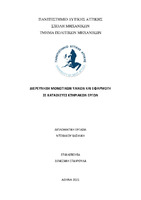| dc.contributor.advisor | Δενεζάκη, Σταυρούλα | |
| dc.contributor.author | Ντοβάκου, Βασιλική | |
| dc.date.accessioned | 2022-12-05T08:25:44Z | |
| dc.date.available | 2022-12-05T08:25:44Z | |
| dc.date.issued | 2021-11-19 | |
| dc.identifier.uri | https://polynoe.lib.uniwa.gr/xmlui/handle/11400/3435 | |
| dc.identifier.uri | http://dx.doi.org/10.26265/polynoe-3275 | |
| dc.description.abstract | Σκοπός της παρούσας εργασίας είναι ο προσδιορισμός των θερμοφυσικών ιδιοτήτων των υλικών και των δομικών στοιχείων, καθώς και ο καθορισμός της μεθοδολογίας για τον έλεγχο της θερμικής επάρκειας του κτηριακού κελύφους τόσο ως προς τα επί μέρους διαφανή και αδιαφανή στοιχεία του, όσο και στο σύνολό του. Με την θερμομονωτική προστασία των δομικών στοιχείων των κτηριακών κατασκευών επιδιώκεται ο περιορισμός στο ελάχιστο δυνατό των ανταλλαγών θερμότητας μεταξύ εσωτερικού και εξωτερικού περιβάλλοντος και η επίτευξη ενός ευχάριστου εσωκλίματος στο εσωτερικό των κτηρίων με τη μικρότερη δυνατή κατανάλωση ενέργειας. Έτσι, κατά την μεν χειμερινή (ψυχρή) περίοδο περιορίζονται οι θερμικές απώλειες προς το εξωτερικό περιβάλλον, κατά δε τη θερινή (θερμή) περίοδο περιορίζεται η υπερθέρμανση λόγων θερμικών προσόδων από την επίδραση της ηλιακής ακτινοβολίας. Ταυτοχρόνως όμως με τη θερμομονωτική προστασία των κτηρίων ελαχιστοποιείται και ο κίνδυνος εκδήλωσης του φαινομένου της επιφανειακής συμπύκνωσης των υδρατμών (δρόσου) και προστατεύονται οι κατασκευές από φαινόμενα υγρασίας του εσωτερικού χώρου. Σε γενικότερο επίπεδο περιορίζεται η απαίτηση για κατανάλωση ενέργειας και κατά συνέπεια μειώνεται η κατανάλωση των διαθέσιμων ενεργειακών πόρων και η ρύπανση του περιβάλλοντος από την παραγωγή αέριων ρύπων. Η απαίτηση για θερμομονωτική προστασία των κτηριακών κατασκευών συμβάλλει προς αυτήν την κατεύθυνση, αξιολογώντας την επάρκεια της θερμομονωτικής προστασίας του κτηρίου: 1. Με τον έλεγχο της θερμομονωτικής επάρκειας των επί μέρους δομικών στοιχείων, 2. Με τον έλεγχο της θερμομονωτικής επάρκειας του κτηριακού κελύφους στο σύνολό του. Σ’ αυτήν την τεχνική οδηγία παρουσιάζεται αναλυτικά η μεθοδολογία αυτού του διπλού ελέγχου θερμομονωτικής προστασίας του κτηρίου αφενός με τον υπολογισμό του συντελεστή θερμοπερατότητας U κάθε επί μέρους δομικού στοιχείου και αφετέρου με τον υπολογισμό του μέσου συντελεστή Um του συνόλου του κτηριακού κελύφους. | el |
| dc.format.extent | 154 | el |
| dc.language.iso | el | el |
| dc.publisher | Πανεπιστήμιο Δυτικής Αττικής | el |
| dc.rights | Αναφορά Δημιουργού - Μη Εμπορική Χρήση - Παρόμοια Διανομή 4.0 Διεθνές | * |
| dc.rights | Attribution-NonCommercial-NoDerivatives 4.0 Διεθνές | * |
| dc.rights.uri | http://creativecommons.org/licenses/by-nc-nd/4.0/ | * |
| dc.subject | Μονωτικά υλικά | el |
| dc.subject | Ενεργειακή κατανάλωση | el |
| dc.subject | Κανονισμός Ενεργειακής Απόδοσης Κτιρίων | el |
| dc.subject | Θερμομονωτικά υλικά | el |
| dc.subject | Πιστοποιητικό ενεργειακής απόδοσης | el |
| dc.title | Διερεύνηση μονωτικών υλικών και εφαρμογή σε κατασκευές κτηριακών έργων | el |
| dc.title.alternative | Investigation of insulating materials and application in construction of building projects | el |
| dc.type | Διπλωματική εργασία | el |
| dc.contributor.committee | Κόκκινος, Φίλης-Τριαντάφυλλος | |
| dc.contributor.committee | Αλογομιά, Μαρία | |
| dc.contributor.faculty | Σχολή Μηχανικών | el |
| dc.contributor.department | Τμήμα Πολιτικών Μηχανικών | el |
| dc.description.abstracttranslated | The purpose of this work is to determine the thermophysical properties of materials and structural elements, as well as to define the methodology for checking the thermal adequacy of the building shell both in terms of its individual transparent and opaque elements and in its entirety. The thermal insulation protection of the structural elements of the building constructions seeks to minimize the heat exchanges between indoor and outdoor environment and to achieve a pleasant indoor interior of the buildings with the lowest possible energy consumption. Thus, during the winter (cold) period, the heat losses to the outside environment are limited, and during the summer (warm) period, the overheating due to thermal revenues due to the effect of solar radiation is limited. At the same time, however, with the thermal insulation protection of the buildings, the risk of the phenomenon of surface condensation of water vapor (dew) is minimized and the structures are protected from indoor moisture phenomena. At a more general level, the demand for energy consumption is reduced and consequently the consumption of available energy resources and the pollution of the environment from the production of gaseous pollutants are reduced. The requirement for thermal insulation of building constructions contributes in this direction, evaluating the adequacy of the thermal insulation protection of the building:
• By checking the thermal insulation adequacy of the individual structural elements, • By checking the thermal insulation adequacy of the building shell as a whole. This technical instruction presents in detail the methodology of this double check of thermal insulation of the building on the one hand by calculating the coefficient of thermal conductivity U of each individual structural element and on the other hand by calculating the average coefficient Um of the whole building shell. | el |



